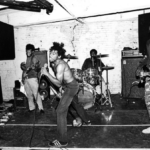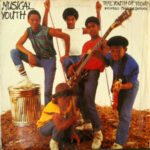 Bad Brains, an influential American band known for their fusion of punk rock and hardcore with reggae, stands as a cornerstone in the evolution of alternative music. Emerging from the vibrant music scene of Washington, D.C. in the late 1970s, Bad Brains brought a unique energy and innovative sound to the forefront of punk and hardcore music. Their journey from their early days to their impact on music and culture reflects a story of creativity, struggle, and resilience.
Bad Brains, an influential American band known for their fusion of punk rock and hardcore with reggae, stands as a cornerstone in the evolution of alternative music. Emerging from the vibrant music scene of Washington, D.C. in the late 1970s, Bad Brains brought a unique energy and innovative sound to the forefront of punk and hardcore music. Their journey from their early days to their impact on music and culture reflects a story of creativity, struggle, and resilience.
Origins and Formation
Bad Brains was formed in 1979 by a group of friends from Washington, D.C., each bringing their own musical influences and backgrounds. The original lineup consisted of HR (Paul Hudson) on vocals, Dr. Know (Gary Miller) on guitar, Darryl Jennifer on bass, and Earl Hudson on drums. The band’s origins can be traced back to a group of high school friends who shared a love for music and a desire to push the boundaries of conventional rock.
The members of Bad Brains initially came together under the name “Mind Power,” but soon changed it to Bad Brains. The new name reflected their commitment to their creative vision and their desire to challenge the status quo. Their early music was heavily influenced by the punk rock scene, but the band’s incorporation of reggae rhythms and themes set them apart from their peers.
One of the most distinctive aspects of Bad Brains was their diverse musical influences. HR’s background in reggae and the Rastafarian faith infused the band’s punk and hardcore sound with a unique spiritual and cultural dimension. This fusion of genres and influences would become a defining characteristic of Bad Brains’ music.
The Early Days and Breakthrough
Bad Brains’ early days were marked by their energetic and chaotic live performances, which quickly earned them a reputation as one of the most exciting bands in the D.C. punk scene. Their shows were known for their intensity, with HR’s frenetic stage presence and the band’s relentless sound captivating audiences.
The band’s breakthrough came with the release of their debut self-titled album in 1982. This album is widely regarded as one of the most influential punk and hardcore records of all time. The album’s raw energy, combined with its innovative fusion of punk and reggae, helped to establish Bad Brains as a pioneering force in the hardcore scene.
Tracks like “Banned in D.C.” and “Pay to Cum” became anthems of the hardcore movement, and the album’s aggressive sound and socially conscious lyrics resonated with fans. The band’s ability to seamlessly blend punk rock and reggae, while maintaining their aggressive edge, set them apart from other bands in the genre.
The release of their debut album was followed by a period of intense touring and live performances. Bad Brains’ shows were characterized by their high-energy performances and the band’s willingness to push the boundaries of punk and hardcore music. Their reputation as one of the most exciting live acts of the era helped to solidify their place in the punk and hardcore scenes.
Innovations and Challenges
As Bad Brains continued to gain recognition, their innovative approach to music and performance began to influence other bands and musicians. The band’s fusion of punk and reggae, combined with their emphasis on spirituality and social consciousness, set them apart from their peers and helped to shape the direction of the hardcore and punk movements.
One of the most significant innovations introduced by Bad Brains was their incorporation of reggae rhythms and themes into their punk rock sound. This fusion of genres was groundbreaking at the time and helped to expand the boundaries of punk and hardcore music. The band’s ability to blend these different styles created a unique sound that resonated with audiences and inspired other musicians to experiment with genre fusion.
Despite their success and influence, Bad Brains faced a number of challenges throughout their career. The band’s unconventional sound and outspoken political and social views often led to difficulties with record labels and the mainstream music industry. Additionally, the band’s members faced personal struggles, including issues with mental health and substance abuse, which affected their ability to consistently tour and record new music.
In the mid-1980s, Bad Brains faced a period of instability and lineup changes. The band’s original drummer, Earl Hudson, was replaced by Mackie Jayson, and the band’s sound began to evolve as they experimented with new musical styles and influences. Despite these changes, Bad Brains continued to release new material and maintain their presence in the punk and hardcore scenes.
The 1980s and 1990s: Evolution and Reformation
During the 1980s and 1990s, Bad Brains continued to evolve and experiment with their sound. The band’s music during this period reflected their willingness to explore new genres and influences, including funk, jazz, and experimental rock. Their ability to adapt and innovate while maintaining their core punk and hardcore identity was a testament to their creativity and resilience.
In 1986, Bad Brains released I Against I, an album that marked a significant departure from their earlier sound. The album featured a more polished production and incorporated elements of funk and heavy metal, reflecting the band’s desire to push the boundaries of their music. I Against I was well received by critics and fans, and it demonstrated the band’s ability to evolve while staying true to their punk and hardcore roots.
The late 1980s and early 1990s saw further changes in the band’s lineup and sound. The band’s original members faced personal and professional challenges, including disputes with record labels and issues with mental health and substance abuse. Despite these difficulties, Bad Brains continued to tour and record new music, maintaining their presence in the punk and hardcore scenes.
In 1993, Bad Brains reunited with their original lineup for a series of live performances and tours. The reunion was marked by a renewed energy and a return to the band’s punk and hardcore roots. The original lineup’s return was a testament to the band’s enduring legacy and their impact on the punk and hardcore movements.
Legacy and Influence
Bad Brains’ influence on punk rock, hardcore, and alternative music is profound and far-reaching. As one of the first bands to successfully fuse punk and reggae, Bad Brains helped to expand the boundaries of punk and hardcore music and inspired countless musicians to experiment with genre fusion.
The band’s innovative approach to music, characterized by their energetic performances, socially conscious lyrics, and willingness to experiment with new sounds and styles, has had a lasting impact on the music world. Their fusion of punk and reggae, combined with their emphasis on spirituality and social consciousness, set them apart from their peers and helped to shape the direction of punk and hardcore music.
Bad Brains’ influence can be seen in the work of subsequent punk and hardcore bands, as well as in the broader alternative music landscape. Their pioneering spirit and willingness to push the boundaries of music have inspired countless musicians and bands to explore new sounds and styles.
The band’s impact is also reflected in their critical acclaim and recognition. Bad Brains’ debut album is widely regarded as one of the most influential punk and hardcore records of all time, and the band’s contributions to the genre have been recognized by critics and fans alike. Their innovative approach to music and their enduring legacy continue to be celebrated by the punk and hardcore communities.
Conclusion
The history of Bad Brains is a story of innovation, resilience, and influence. From their early days in Washington, D.C. to their impact on punk and hardcore music, Bad Brains has left an indelible mark on the music world. Their fusion of punk and reggae, combined with their energetic performances and socially conscious lyrics, has made them one of the most important and influential bands in the history of alternative music.
Despite the challenges they faced throughout their career, Bad Brains’ commitment to their creative vision and their willingness to push the boundaries of music have ensured their place in music history. Their pioneering spirit and enduring legacy continue to inspire new generations of musicians and fans, and their impact on punk and hardcore music remains a testament to their innovation and influence.
This post has already been read 247 times!









